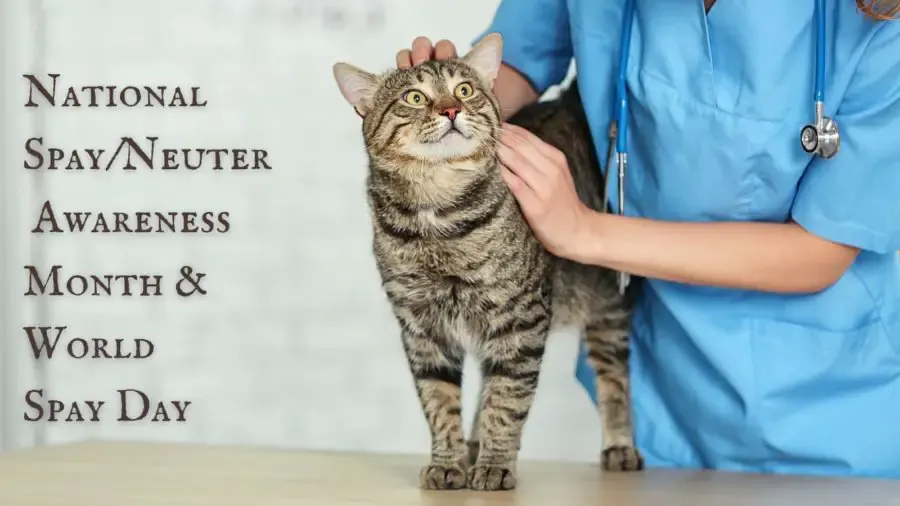Each year 6 – 8 million cats and dogs enter the U.S. shelter system– fewer than half are lucky enough to find forever homes. To help turn the tide on the staggering statistics, every year National Spay/Neuter Awareness Month and World Spay Day shine the spotlight on the need to spay and neuter our pets.
Not only does altering our four-legged friends play a significant role in ‘fixing’ the problem of pet overpopulation, and helps homeless companion animals who might face their fate in an animal shelter due to overcrowding, spaying and neutering. Read to learn how you can also enrich (and possibly save) the life of your own furry family member as well!

When is National Spay/Neuter Awareness Month?
National Spay/Neuter Awareness Month is observed every year in February.
When is World Spay Day?
National Spay/Neuter Awareness Month broadens its outreach on World Spay Day, which takes place each year on the final Thursday in February.
World Spay Day began in 1995 as Spay Day USA, an event launched by animal advocate Doris Day. The Doris Day Animal Foundation provides grants to fund surgeries, and today the event is spearheaded by the Humane Society of the United States.
Created to combat the crisis of pet overpopulation in every corner of the globe, animal lovers are encouraged to spread the word through social media and help to raise funds for the paws cause.
Benefits of Spay/Neuter for Your Cat
Sterilization can help to curb potentially perilous behavior, such as the urge to roam, which makes a pet more vulnerable to diseases and more likely to be injured or killed by various outdoor dangers, including passing cars.
Sterilized pets often exhibit fewer behavioral problems. For example, neutered males are less likely to mark their territory or show aggression. Spayed females won’t go into heat, which means they won’t attract males and exhibit the often disruptive behaviors associated with the heat cycle.
Spaying and neutering also adds to the longevity of our purring pals and barking buddies, with dogs living an average of 1 to 3 years longer and cats 3 to 5 years more by reducing the risk of certain cancers, the American Veterinary Medical Association reports. For instance, spaying can prevent uterine infections and breast tumors in female pets, while neutering can prevent testicular cancer and certain prostate issues in males.
Finding Low Cost Spay/Neuter Programs
Recognizing that cost can be a barrier, some organizations and clinics offer reduced-cost or even free spay/neuter programs, especially during this awareness month, to help low-income pet owners.
Finding low-cost or free spay/neuter services can significantly help cat lovers ensure their pets’ well-being (and the well-being of feral cats they may be assisting) without breaking the bank. Here’s a look at affordable spay/neuter options:
Local Animal Shelters and Rescues: Many animal shelters offer low-cost spay/neuter programs or can guide you to local resources. Start by contacting the shelters and rescues in your area. In our area, the local shelter also has a low-cost spay/neuter day for feral cats so that you can bring them in then return the cats to their home after surgery.
Veterinary Schools: If you live near a veterinary college or training school, they might offer spay/neuter services at a reduced cost as part of their training programs.
Spay/Neuter Clinics: Some areas have dedicated spay/neuter clinics that exclusively offer sterilization surgeries, often at a reduced cost compared to full-service veterinary clinics.
National Organizations:
- The ASPCA (American Society for the Prevention of Cruelty to Animals) has a database of low-cost spay/neuter programs. Visit their website and enter your zip code to find services near you.
- PetSmart Charities partners with various organizations to offer affordable spay/neuter services.
Local Events: Keep an eye out for local events, especially during National Spay/Neuter Awareness Month (February). Organizations often hold special clinics or events offering discounted services.
State or Municipal Programs: Some states or local municipalities offer subsidized spay/neuter programs as part of their animal control initiatives. Check with your local government or animal control office.
Pet Welfare Organizations: Groups like SpayUSA, Alley Cat Allies, and Friends of Animals often have directories or can provide vouchers for discounted spay/neuter services.
Talk to Your Vet: Even if your regular veterinarian doesn’t offer discounted services, they might know of local programs or other vets who do.
Online Groups: Local online community boards, pet forums, or social media groups can be excellent resources. Members often share their experiences and can guide you to affordable options in your area.
Consider Income-Based Programs: Some programs offer sliding scale fees based on your income. If you’re facing financial hardships, look for programs that determine fees based on income.
Network: Talk to fellow pet owners, friends, and family. Word of mouth can sometimes lead you to lesser-known, affordable services in your area.
More Cat Holidays
National Spay/Neuter Awareness Month and World Spay Day are just two of many February cat holidays here on CatTipper. You also might enjoy:
National Drink Wine with Your Cat Week
- Tyler Bass Fans Donate to Cat Adoption Group - January 24, 2024
- Saint Gertrude of Nivelles, Patron Saint of Cats - January 19, 2024
- Offensive Tackle Daniel Faalele’s Defensive Play for Animal Rights - December 27, 2023
